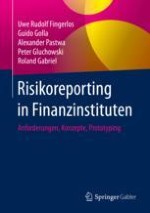2020 | OriginalPaper | Buchkapitel
4. Detailliertes Fallbeispiel zur Kreditdatenanalyse auf Basis von RStudio
verfasst von : Uwe Rudolf Fingerlos, Guido Golla, Alexander Pastwa, Peter Gluchowski, Roland Gabriel
Erschienen in: Risikoreporting in Finanzinstituten
Verlag: Springer Fachmedien Wiesbaden
Aktivieren Sie unsere intelligente Suche, um passende Fachinhalte oder Patente zu finden.
Wählen Sie Textabschnitte aus um mit Künstlicher Intelligenz passenden Patente zu finden. powered by
Markieren Sie Textabschnitte, um KI-gestützt weitere passende Inhalte zu finden. powered by
